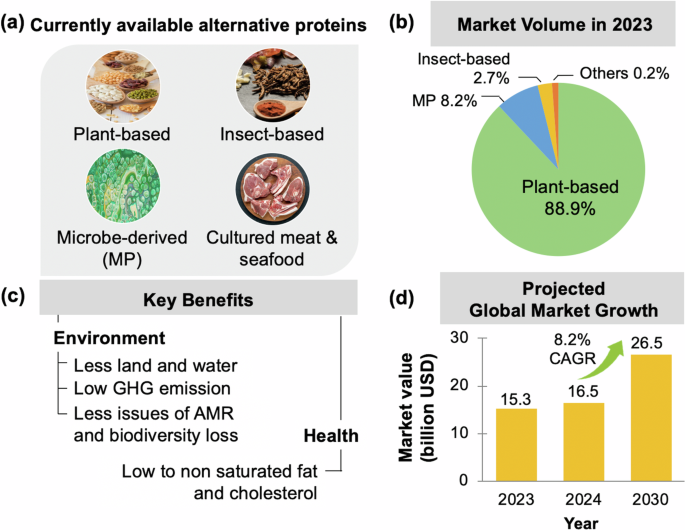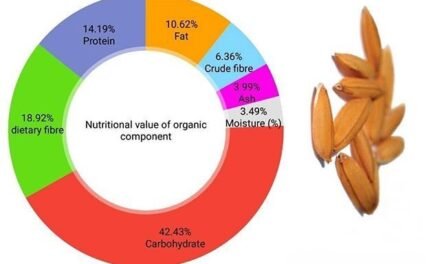The rise of alternative proteins is reshaping traditional food industries, creating both challenges and opportunities. These innovations in plant-based, cell-cultured, and fermentation-derived proteins are influencing consumer demand, production practices, and market dynamics. Here’s how alternative proteins are impacting traditional food industries:
1. Changing Consumer Preferences
- Impact: Increasing consumer demand for sustainable, health-conscious, and cruelty-free options is driving the shift toward alternative proteins.
- Effects on Traditional Industries:
- Reduced demand for conventional meat, dairy, and seafood products.
- Companies are reformulating products to include alternative protein options.
- Example: Many traditional meat producers now offer plant-based or hybrid meat products.
2. Competition and Market Share Shifts
- Impact: Alternative proteins are gaining market share, especially among flexitarians and younger demographics.
- Effects on Traditional Industries:
- Declining growth in traditional meat and dairy sectors in regions with high adoption of alternative proteins.
- Increased pressure to diversify product portfolios to stay competitive.
- Example: Major fast-food chains like McDonald’s and Burger King offer plant-based burgers alongside traditional options.
3. Innovation and Product Development
- Impact: Alternative proteins have spurred innovation in food production, leading to new categories and products.
- Effects on Traditional Industries:
- Traditional companies are investing in R&D to create hybrid or alternative products.
- Collaboration between traditional food producers and alternative protein startups.
- Example: Tyson Foods, a leading meat producer, has invested in plant-based and cultured meat startups.
4. Supply Chain Disruption
- Impact: Alternative proteins require different raw materials, production facilities, and distribution channels.
- Effects on Traditional Industries:
- Increased competition for crops like peas, soy, and other protein sources used in alternative products.
- Adjustments in supply chains to accommodate new production processes.
- Example: Companies sourcing plant-based proteins are competing with traditional livestock feed producers for raw materials.
5. Sustainability and Environmental Pressures
- Impact: Alternative proteins appeal to consumers and regulators focused on reducing the environmental footprint of food production.
- Effects on Traditional Industries:
- Traditional industries are adopting more sustainable practices to compete with the lower environmental impact of alternatives.
- Emphasis on carbon-neutral or regenerative agriculture to address sustainability concerns.
- Example: Dairy companies exploring methane-reducing feed additives to lower emissions from livestock.
6. Investment and Market Opportunities
- Impact: The alternative protein sector has attracted significant venture capital and corporate investment.
- Effects on Traditional Industries:
- Traditional companies are entering the alternative protein market through acquisitions or partnerships.
- Diversification into high-growth areas to capitalize on consumer trends.
- Example: Nestlé’s launch of plant-based product lines alongside its traditional offerings.
7. Regulatory and Labeling Challenges
- Impact: Alternative proteins face evolving regulatory frameworks and labeling requirements.
- Effects on Traditional Industries:
- Traditional industries lobby for stricter labeling regulations to distinguish alternative products from conventional ones.
- Need for clear communication about product origins, particularly for cultured meat or precision-fermented proteins.
- Example: Debates over whether plant-based “milk” can be labeled as milk in various countries.
8. Health and Nutrition Considerations
- Impact: Alternative proteins are marketed as healthier options, focusing on reduced cholesterol, fat, and allergens.
- Effects on Traditional Industries:
- Reformulation of traditional products to align with health-conscious trends (e.g., leaner cuts, reduced sodium).
- Development of fortified or functional animal-based products to compete.
- Example: Fortified dairy products with added vitamins or probiotics competing with plant-based alternatives.
9. Consumer Education and Trust
- Impact: Consumers require education on the safety, taste, and benefits of alternative proteins.
- Effects on Traditional Industries:
- Traditional industries emphasize the natural and time-tested nature of their products to maintain consumer trust.
- Marketing campaigns highlighting traditional products’ nutritional value and cultural significance.
- Example: Beef and dairy associations promoting the benefits of natural animal proteins.
10. Employment and Workforce Shifts
- Impact: Growth in alternative protein industries creates new job opportunities but challenges traditional sectors.
- Effects on Traditional Industries:
- Transitioning labor forces from conventional meatpacking to high-tech production facilities for alternative proteins.
- Upskilling workers to operate in hybrid production environments.
- Example: Retraining programs for workers in conventional agriculture to support alternative protein manufacturing.
11. Cultural and Culinary Integration
- Impact: Alternative proteins are increasingly accepted in mainstream culinary applications.
- Effects on Traditional Industries:
- Traditional food industries adapt by incorporating alternative proteins into blended products (e.g., half-meat, half-plant patties).
- Exploration of recipes that complement both traditional and alternative protein options.
- Example: Chefs and food brands integrating plant-based proteins into traditional dishes like lasagna or tacos.
12. Global Market Dynamics
- Impact: Adoption rates of alternative proteins vary globally based on cultural, economic, and regulatory factors.
- Effects on Traditional Industries:
- Traditional food companies in regions with high alternative protein adoption face greater disruption.
- Companies in developing markets balance affordability and accessibility while introducing alternative products.
- Example: Alternative proteins are gaining traction in North America and Europe, while traditional products still dominate in regions like Asia and Africa.
Challenges for Traditional Industries
- Taste and Texture Parity: Alternative proteins are continually improving, challenging traditional products’ sensory superiority.
- Price Competition: Economies of scale for alternative proteins are driving price parity with traditional options.
- Consumer Perception: Combating the perception of traditional protein products as environmentally harmful or less ethical.
Opportunities for Collaboration
- Blended Products: Combining animal and alternative proteins to create transitional products.
- Dual Branding: Offering both traditional and alternative protein options under the same brand.
- Sustainability Leadership: Leveraging traditional expertise in farming and production to lead in sustainable practices.
Conclusion
Alternative proteins are transforming traditional food industries by reshaping consumer preferences, supply chains, and market dynamics. While they pose challenges to conventional meat and dairy sectors, they also create opportunities for innovation, collaboration, and growth in a more sustainable food system. Traditional industries that adapt to these trends are well-positioned to thrive in a rapidly changing market.
Hashtags
#CleanEating #HealthyHabits #EcoFriendlyEating #MeatFreeMonday #VeganLifestyle #SustainableLiving #FoodRevolution #MeatlessMeals #EcoConscious #PlantPowered #InnovativeFoods #SustainableSolutions #HealthyPlanet #MeatAlternatives #EcoFriendlyChoices #SustainableDiet #GreenEating #FoodInnovation #EcoFriendlyFood #SustainableChoices









